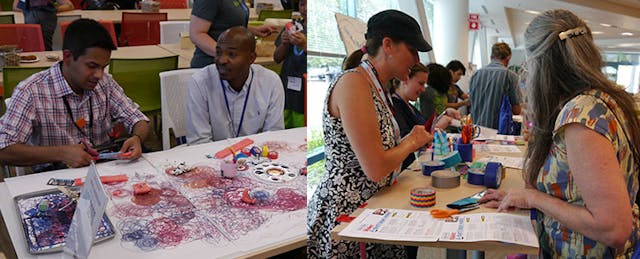There are a few key buzzwords floating around the education world and mediascape that drive some educators nuts--“standards,” “data-driven alignment,” “value-added.” But last Thursday in one area of the world, teachers came together to chat with some new terminology, namely “bottom-up” and “subversive.”
“Subversive” was the keyword of the day at Maker Ed and Intel’s “Making Possibilities Workshop” for educators on Thursday, May 15, and it was Dale Dougherty--founder of Make Magazine and Co-Founder of Maker Faire--who said it first.
“I could probably make it easier for all of us if I said that [Making] aligns perfectly with all the educational standards and all the mainstream thought in education…” Dougherty said during his morning keynote. “But I think it’s actually subversive.” He continued:
“It’s subversive because it’s causing change, and innovation… It’s a desire to change the way things are, and making in schools needs to be subversive if we’re going to invite kids to actually do things that are meaningful to them.”
This past weekend in San Mateo, Calif., the 9th annual Maker Faire drew more than 130,000 people. But on the Thursday before the event, more than 100 educators (and five students, too!) gathered at Intel Corp.’s headquarters for a day of tinkering, idea-sharing, and analyses of where Making fits into the K-12 edspace.
The day featured workshops in which teachers explored blending K-12 with the Maker movement (from “Research and Evaluation: Making Educational Outcomes” to “Making to Younger Audiences: Imagination, Play, and Learning”), tours of the SAM “Science-Art-Music” Academy on Wheels and a “Possibility Faire” with demos from the likes of LA community makerspace, The Exploratory, and young student makers from across the country.
Students were vocal about what is--and is not--working in education, and how they hope Making can solve that. Fourteen-year-old Schuyler St. Leger wasn’t shy about why he thinks Making is a better way to teach core concepts: “With so many things in schools, there’s a right and a wrong answer. Why? When you Make, you can teach students trigonometry without ever saying the word “trigonometry.”
Dougherty agreed with St. Leger, adding, “We give this messages of ‘You aren’t good at math,’ but every kid needs math capabilities. I think we’re on the cusp of change where Making will be practiced in schools more widely.”
The Road to Subversion
So how does one exactly subvert the existing system of K-12? Discussions throughout the day moved to focusing on a bottom-up approach, with teachers as “changemakers” and introducers of new Making practices in curriculum structures.
Final keynoter of the day Sylvia Martinez crafted a series of top ten items that “Maker educators know.” Three ideas touched directly on strategies brought up by educators throughout the day for bringing Making into the K-12 environment--even when an administrator, district official, or politician isn’t so into it.
Just do it!
Martinez’s first item was a reference to “throwing-caution-to-the-wind” attitudes when it comes to Making in the classroom--a reference made several times as a way to subvert K-12 by educators throughout the day.
Case in point: An activity where the educator attendees created a “coloring maker bot” with a motor, markers, and plastic cup during the “Making in Underserved Communities” session. Educator Nancy Silva found herself unsure of how to put it together or approach the task, but eventually changed her tune: “Somebody said ‘just try it,’ and that’s an idea that I can stick to.”
“I’d much rather do it this way than any other way when it comes to STEM activities,” said Robbie Munsey, a physics/chemistry teacher at Albemarle County Public Schools in Virginia, during the “Advocating to Administrators” session. “And when I want people to support me, I take to Twitter, Facebook. I’ll create my own cheering squad,” he declared.
“Aim small, miss small, and tell yourself ‘I’m gonna do this thing,’” added Chad Ratliff, an Albemarle district administrator. STEM expert Rebecca Vyduna added: “Do first, ask for forgiveness later.”
Educate everyone.
Educating the masses (and we’re not just talking teachers--parents, students, and admins, too) is a crucial step in getting Making into schools, Martinez said. Attendees agreed as well, both for their own learning and that of people around them.
Educator Frances Wilson, attending on behalf of the National Society of Black Engineers, spoke to the helpfulness of the Maker Education Initiative in that process: “They gave us a venue to find out more about what making is,” with ideas that she’ll take back to the digital training sessions she conducts with students at Pittsfield High School in Oakland, CA. Lisa Regalla, National Program Director for MakerEd, added to this: “The key for today’s event was networking. We want to get educators to meet other educators, connect afterwards, and communicate online.”
Educating administrators, parents, and the surrounding community is equally important, especially in rural and urban communities where resources are scarce, noted attendees. “Sit administrators down with a kid and have them Make. It’s all about teaching, and it’s hard to deny when something’s that good for kids,” said Ratliff.
Jerry Valdez, founder of SAM “Science-Art-Music” Academy, argued the community engagement point when he talked about taking his traveling Maker mobile up and down the California coast, connecting all community members to the importance of STEAM (that’s “art” included in there) in education.
“We serve kids who need it,” he says. “Things keep getting shut down in public schools. We need to get away from standards and get closer to Making.”
You (and your kids) are the right people.
Anyone can be a Maker--no matter what their background. “Everyone makes something” was the key idea in the “Making in Underserved Communities” session, a uniting force amongst students, parents, and the community.
Interested in becoming a part of the conversation? Check out the Tweets from both the Bay Area Maker Faire and Intel’s “Making Possibilities” workshop. And for more information in the future, check out MAKE Magazine and the Maker Education Initiative.


